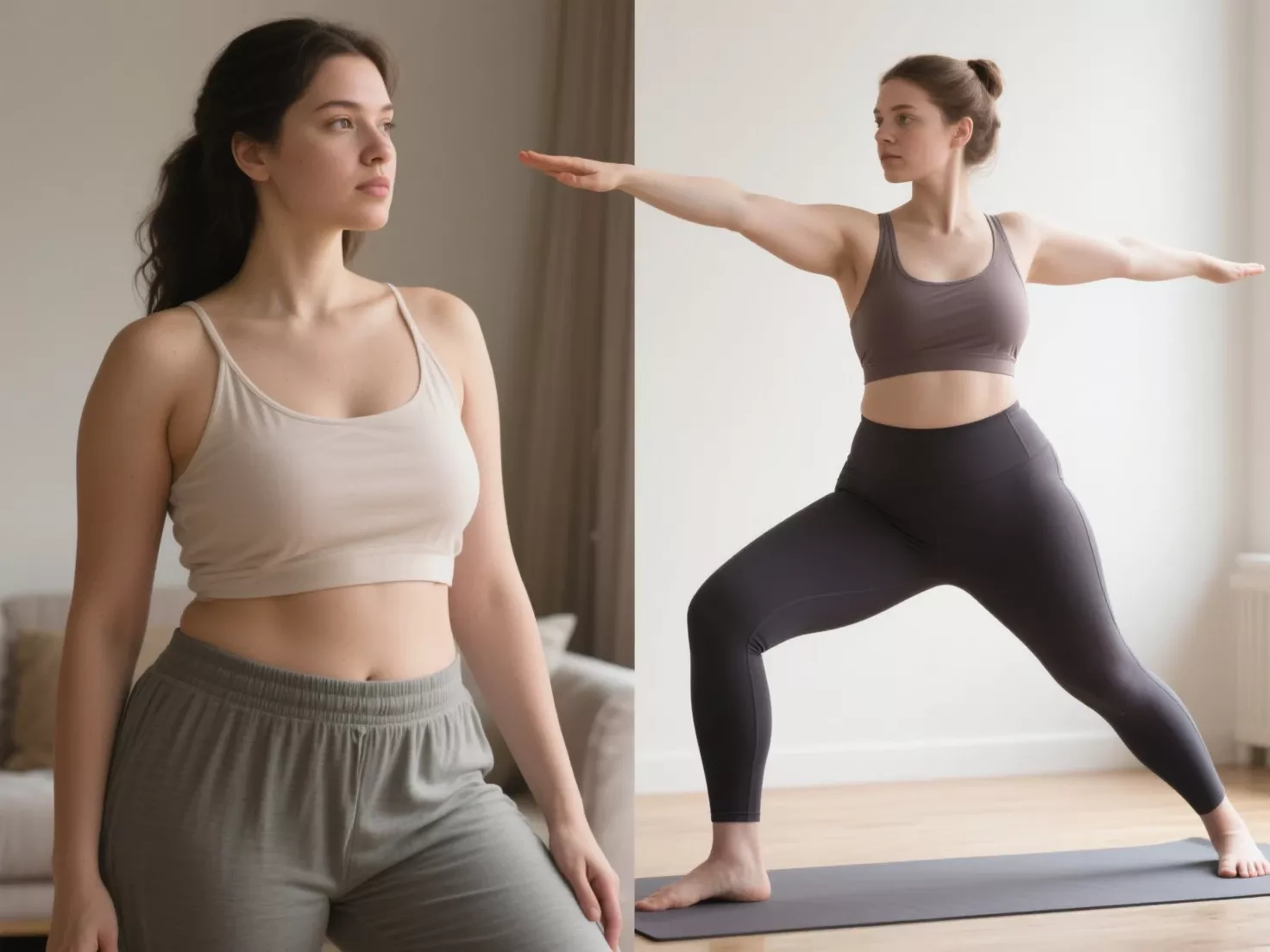Music can play a powerful role in enhancing your yoga practice, helping to set the tone, guide your flow, and create a deeper sense of relaxation or focus.
Choosing the right music depends on the type of yoga you’re practicing, your personal preferences, and the atmosphere you wish to create.

Here’s a detailed guide to selecting the perfect music for your yoga sessions.
1. Gentle and Ambient Music for Relaxation

For calming practices like Yin Yoga, Restorative Yoga, or meditation, ambient music with soft tones and slow tempos can help you relax and connect to your breath.
Why It Works:
- Encourages deep relaxation by calming the mind.
- Creates a serene atmosphere for stillness and introspection.
- Minimizes distractions, keeping you present in your practice.
Popular Choices:
- Tracks with nature sounds like waterfalls, birdsong, or ocean waves.
- Ambient artists such as Brian Eno, Sigur Rós, or Hammock.
- Traditional yoga-inspired sounds, including Tibetan singing bowls or Indian flutes.
Playlist Tip:
Look for Spotify playlists like “Yoga & Meditation Music” or “Peaceful Meditation Sounds.”
2. Upbeat Rhythms for Dynamic Flows
For practices like Vinyasa or Power Yoga, music with a steady rhythm and uplifting energy can help you maintain focus and flow through poses.
Why It Works:
- The rhythm aligns with breath and movement, creating a meditative flow.
- Motivates you during physically demanding sequences.
- Adds a dynamic energy to your practice.
Popular Choices:
- Instrumental tracks with soft electronic beats.
- Indie or acoustic songs with a positive vibe.
- World music with rhythmic drumming or chanting.
Playlist Tip:
Try playlists like “Vinyasa Flow Beats” or “Yoga Energy Boost” for curated options.
3. Classical or Instrumental Music for Focus

For Hatha Yoga or slow-paced practices, instrumental and classical music creates a focused yet peaceful ambiance.
Why It Works:
- The absence of lyrics allows for mental clarity and deeper concentration.
- The soothing tones of piano, strings, or sitar complement mindful breathing.
Popular Choices:
- Classical composers like Ludovico Einaudi or Johann Sebastian Bach.
- Instrumental yoga music featuring sitar, tabla, or harp.
- Ambient instrumental albums like Music for Yoga and Meditation by Deepak Chopra.
Playlist Tip:
Search for “Instrumental Yoga” or “Classical Relaxation” on music platforms.
4. Mantras and Chanting for Spiritual Connection
For Kundalini Yoga or practices with a spiritual focus, mantra music and chanting create a meditative and uplifting energy.
Why It Works:
- The repetition of mantras helps calm the mind and elevate spiritual awareness.
- Chanting and sacred sounds like “Om” resonate deeply, aligning your energy.
Popular Choices:
- Artists like Snatam Kaur, Deva Premal, or Krishna Das.
- Traditional chants like the Gayatri Mantra or the Om Namah Shivaya.
Playlist Tip:
Explore playlists like “Sacred Chants” or “Kundalini Yoga Mantras.”
5. Silence as Music
Sometimes, the best soundtrack for yoga is no music at all. Practicing in silence can deepen your connection to your body and surroundings.
Why It Works:
- Allows you to fully focus on your breath and inner sensations.
- Helps cultivate mindfulness and awareness.
- Eliminates external distractions for a pure, meditative experience.
When to Choose Silence:
- During meditation or restorative practices.
- When practicing outdoors to connect with natural sounds.
Tips for Creating Your Yoga Playlist

1. Match the Tempo to Your Practice:
- Use slower, relaxing tracks for gentle flows and meditation.
- Opt for rhythmic or energetic music for dynamic sequences.
2. Choose Music Without Disruptive Lyrics:
- Instrumental or non-verbal tracks prevent your mind from focusing on words instead of your practice.
3. Use Pre-Curated Playlists:
- Platforms like Spotify, Apple Music, and YouTube offer yoga-specific playlists tailored to different styles and moods.
4. Adjust Volume Mindfully:
- Keep the music at a low to moderate volume so it enhances, rather than overpowers, your practice.
5. Experiment and Evolve:
- Try different styles of music to see what resonates with you. Your preferences might change depending on the day or your practice goals.
Music can be a powerful tool to elevate your yoga practice, whether you’re seeking energy, relaxation, or spiritual connection.
The key is to choose music that aligns with your intentions and enhances your experience.
Whether you prefer soothing mantras, ambient melodies, or the pure sound of silence, let your choice guide you into deeper flow and mindfulness.
Why is Music Important in Yoga?
Music is often considered an integral part of a yoga practice, enhancing the experience by creating an atmosphere that fosters relaxation, focus, and flow.
While yoga itself is deeply rooted in mindfulness and movement, the right music can elevate the practice, connecting the body, mind, and spirit in a harmonious way.
Here’s a detailed exploration of why music plays a significant role in yoga.
1. Sets the Tone for Your Practice
How It Helps:
Music establishes the mood and energy of your yoga session. Whether you’re practicing a calming Restorative Yoga session or an invigorating Power Yoga flow, the tempo and tone of the music can guide your movements and breathing.
Examples:
- Slow, ambient music for gentle or meditative practices.
- Rhythmic beats for energetic Vinyasa or Ashtanga Yoga sessions.
Why It Matters:
A well-curated playlist can transport you into the right mindset, making it easier to let go of distractions and immerse yourself in the practice.
2. Enhances Focus and Mindfulness
How It Helps:
Music can act as a tool to center your attention, drawing your mind away from wandering thoughts and into the present moment. Repetitive melodies or chants, in particular, can help anchor your awareness during meditation or challenging poses.
Examples:
- Mantras like “Om” or “Om Mani Padme Hum” create a rhythmic mental focus.
- Instrumental tracks with consistent tempos encourage a meditative state.
Why It Matters:
It’s common for the mind to drift during yoga. Music provides a gentle reminder to return to your breath and movements, enhancing mindfulness.
3. Synchronizes Breath and Movement
How It Helps:
Yoga places a strong emphasis on coordinating breath with movement (vinyasa). Music with a steady rhythm can serve as a natural metronome, helping you maintain a consistent pace.
Examples:
- Flowing piano melodies or soft drumbeats can guide transitions between poses.
- Upbeat, rhythmic music complements fast-paced sequences.
Why It Matters:
Synchronizing breath with movement promotes a deeper mind-body connection and enhances the meditative quality of your practice.
4. Encourages Emotional Release
How It Helps:
Music has the power to evoke emotions, allowing you to release pent-up tension or stress.
Gentle melodies and harmonious sounds can create a safe space for emotional exploration and healing.
Examples:
- Soft instrumental pieces for grounding and emotional release during Savasana (Corpse Pose).
- Heart-opening tracks with uplifting themes during backbends.
Why It Matters:
Yoga is not just a physical practice—it’s a mental and emotional journey. Music can amplify these transformative aspects, making your practice more meaningful.
5. Supports Relaxation and Stress Reduction
How It Helps:
Calming music activates the parasympathetic nervous system, promoting relaxation and reducing stress.
This is especially beneficial during the cool-down phase of your yoga practice or during meditation.
Examples:
- Ambient music with nature sounds like rain, waves, or wind.
- Tracks with Tibetan singing bowls or soft chimes to create a soothing atmosphere.
Why It Matters:
Music helps your body and mind unwind, making it easier to let go of daily stressors and fully relax in poses like Savasana or Child’s Pose.
6. Fosters a Spiritual Connection
How It Helps:
Music in yoga often draws from ancient traditions, incorporating mantras, chanting, or instruments like the sitar and tabla.
These elements deepen the spiritual aspect of your practice, fostering a sense of connection to something greater than yourself.
Examples:
- Traditional kirtan or bhajans (devotional songs).
- Sacred chants like the Gayatri Mantra or Om Namah Shivaya.
Why It Matters:
For practitioners seeking a spiritual experience, music can serve as a bridge between the physical and the transcendent, enriching the meditative aspects of yoga.
7. Builds a Sense of Flow and Continuity
How It Helps:
A carefully curated playlist can create a seamless flow throughout your session, guiding you from the warm-up to the peak poses and into relaxation.
Music transitions can mirror the energy shifts in your practice.
Examples:
- Upbeat tracks during challenging sequences like Sun Salutations.
- Slow, peaceful melodies during cool-down poses and meditation.
Why It Matters:
Music enhances the narrative of your practice, providing a sense of continuity and cohesion from start to finish.
8. Customizes Your Experience
How It Helps:
Music allows you to tailor your practice to your needs and preferences. Whether you want a calming, introspective session or an energizing, high-energy flow, the right music can help you create your ideal yoga environment.
Examples:
- Create playlists that reflect your mood or intention for the practice.
- Explore different genres, from traditional yoga music to contemporary beats.
Why It Matters:
Yoga is a personal journey, and music provides an opportunity to make each session uniquely yours.
Tips for Incorporating Music into Your Yoga Practice
Match Music to Yoga Style:
- Use slow, soothing tracks for Yin or Restorative Yoga.
- Opt for rhythmic, energetic music for Vinyasa or Power Yoga.
Experiment with Genres:
- Explore instrumental, ambient, classical, or mantra-based music to see what resonates with you.
Adjust Volume:
- Keep the music at a low or moderate volume so it enhances your practice without overpowering it.
Curate Playlists:
- Create playlists for different types of yoga sessions, such as morning flows, evening relaxation, or meditative practices.
Conclusion
Music enriches yoga by creating a supportive environment that aligns with your intentions and practice goals.
Whether it’s calming ambient sounds, rhythmic beats, or sacred chants, music has the power to transform your yoga experience, making it more enjoyable, focused, and meaningful.
Explore different styles and find what resonates with you to enhance your journey on the mat.



